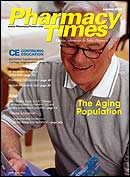Publication
Article
Pharmacy Times
Early Preventive Care Reduces Risk of Osteoporosis
Author(s):
Osteoporosis is a silent disease without a cure; several preventive measures and treatment options are available, particularly for women, the population most affected.
Ms. Terrie is a clinical pharmacywriter based in Haymarket, Virginia.
Osteoporosis (porous bone) is adisease that causes low bonedensity and structural deteriorationof the bone tissue, causingfragility of the bone and an increasedrisk of hip, spine, and wrist fractures.1This condition affects an estimated 10million people in the United Statesolder than age 50; 80% are women.1,2Another estimated 34 million peoplehave osteopenia (low bone mass),which is a risk factor for the developmentof osteoporosis.1,2
Women are more susceptible toosteoporosis, have a lower peak bonemass and smaller bones than men, andlose bone at a much more acceleratedpace than men in middle age becauseof the reduction of estrogen levels duringmenopause.1 In addition, womenmay lose up to 20% of their bone massin the first 5 to 7 years after menopause.1,2
It is estimated that osteoporosis isresponsible for >1.5 million fractures annually,including an estimated 300,000hip fractures, 700,000 vertebral fractures,250,000 wrist fractures, and>300,000 fractures at other sites.1,3 Ingeneral, the average woman hasobtained 98% of her skeletal mass byage 20; therefore, increasing awarenessof the importance of strong bones duringthe early years may be beneficial todecreasing one's risks of osteoporosis.3
Signs and Symptoms of Osteoporosis
Osteoporosis is commonly known asa silent disease because no symptomsare present in the early disease stages;however, in the later stages, a patientmay initially experience fractures ofthe vertebrae, wrists, or hips and othersymptoms that may include the following1,2,4:
- Lower back pain
- Neck pain
- Loss of height over time
- Stooped posture
- Bone pain or tenderness
Risk Factors
Various nonmodifiable and modifiablerisk factors are associated with anincrease incidence of osteoporosis.1,2,4-6
The long-term use of certain medicationsalso can cause bone loss and anincreased risk of osteoporosis. Examplesinclude heparin, some anticonvulsants,aromatase inhibitors, antacidscontaining aluminum, corticosteroids,gonadotropin-releasing hormone agonistsused for treating endometriosis,lithium, methotrexate, and thyroxine.1-7Patients with any concerns about thelong-term use of these medicationsshould be encouraged to discuss themwith their primary health care provider.
Diagnosis
Web sites on osteoporosis:
- NIH National Institute of Arthritis andMusculoskeletal and Skin Diseases atwww.niams.nih.gov.
- NIH Osteoporosis and Related BoneDiseases National Resource Center atwww.niams.nih.gov.
- National Osteoporosis Foundation atwww.nof.org.
- NIH National Institute on AgingInformation Center atwww.nia.nih.gov.
Diagnostic tests for osteoporosisinclude bone mineral density tests tomeasure bone density in various partsof the body. The most common testused is a dual-energy x-ray absorptiometry(DXA) test. A DXA test candetect osteoporosis before a fractureoccurs, predict the chances of a fractureoccurring, confirm a diagnosis ofosteoporosis, ascertain the rate ofbone loss, and assess the effects of thechosen therapy.1,2,4,6
Treatment
The main goal in treating osteoporosisis to prevent fractures. Although nocure exists for osteoporosis, severalFDA-approved pharmacologic agentsexist for treating or preventing osteoporosis.These pharmacologic agentsinclude calcium and vitamin D, bisphosphonates,selective estrogen receptormodulators (SERMs), calcitonin-salmon,teriparatide, and hormone replacementtherapy. Pharmacists have a crucialrole in ensuring that patients areeffectively counseled on the properadministration of these agents, the adverseeffects associated with their use,and the importance of adhering to theprescribed therapy.
Calcium and Vitamin D
Patients should be encouraged todiscuss the use of calcium and vitaminD supplementation with their primaryhealth care provider to determine theamount of calcium that is adequate fortheir age group. The National OsteoporosisFoundation recommends thatwomen have a daily intake of 1000 to1300 mg of calcium and 400 to 800international units of vitamin D, whichshould be obtained through diet, supplements,or both.8
Bisphosphonates
The bisphosphonates include alendronate(Fosamax), alendronate withcalcium (Fosamax D), risedronate(Actonel), risedronate with calcium(Actonel D), and ibandronate (Boniva).They are approved for both the preventionand treatment of postmenopausalosteoporosis. Alendronate also is approvedto treat bone loss that resultsfrom glucocorticoid use and is approvedfor treating osteoporosis in men.1,9 Inaddition, risedronate is approved to preventand treat glucocorticoid-inducedosteoporosis and to treat osteoporosisin men.1,10
Alendronate is available in daily andweekly doses, and alendronate plusvitamin D is available in a weeklydose.9,11 Risedronate is available in dailyand weekly doses, and risedronate withcalcium is available in a weeklydose.1,10,11 Ibandronate is indicated forthe prevention and treatment of postmenopausalosteoporosis in womenand is available in a monthly oral doseand as an intravenous (IV) injectionadministered once every 3 months. Themost common adverse effects associatedwith the injection include flu-like illness,headache, and bone, muscle, orjoint pains.11,12

In August 2007, the FDA approvedanother bisphosphanate, zoledronicacid (Reclast), for the treatment of osteoporosisin postmenopausal women.Zoledronic acid is administered intravenouslyonce a year, and once administered,it rapidly moves to bone andpreferentially localizes at sites of highbone turnover.11,13 Reclast is suppliedas 5 mg in a 100-mL, ready-to-infusesolution for IV administration. The recommendedinitial dose of the drug is a5-mg infusion given intravenously overno less than 15 minutes once a year.13
Pharmacists should counsel patientsto take oral bisphosphonates on anempty stomach with at least 6 to 8 ozof water upon waking in the morning,remain in an upright position, and noteat or drink anything (including othermedications) for at least 30 minutesafter administration. The manufacturerof ibandronate recommends waiting atleast 60 minutes after administration.The use of bisphosphonates is contraindicatedin patients with severerenal disease, hypocalcemia, or inpatients with disorders of the esophagus.11 Common adverse effects of oralbisphosphonates include irritation ofthe upper gastrointestinal mucosa,nausea, dizziness, and headache.9,11,14
SERMs
Raloxifene (Evista), which is classifiedas a SERM, is approved for thetreatment and prevention of postmenopausalosteoporosis. Studieshave shown it to prevent bone loss,have beneficial effects on bone mass,and reduce the incidence of spine fractures.1 This agent is taken once daily.The most common adverse effectsassociated with its use include hotflashes, sweating, thrombosis, musclesoreness, and weight gain.11,15
Calcitonin
Calcitonin is a naturally occurringhormone involved in calcium regulationand bone metabolism and isapproved for the treatment of osteoporosisin women who are at least 5years beyond menopause. Calcitoninsalmon(Miacalcin) is currently availableas a single daily nasal spray or asa subcutaneous injection. Although itdoes not affect other organs or systemsin the body, injectable calcitoninmay cause an allergic reaction andunpleasant side effects, includingflushing of the face and hands, polyuria,nausea, and skin rash. Rhinorrheais the only adverse effect reported withnasal calcitonin.11,16
Teriparatide
Teriparatide (Forteo) is an injectableform of human parathyroid hormone.Its approved indications are for postmenopausalwomen and men withosteoporosis who are at high risk forhaving a fracture. Common adverseeffects include nausea, dizziness, andleg cramps. Teriparatide is approved foruse for up to 24 months.1,11,17
Estrogen/Hormone Therapy
Estrogen/hormone therapy (ET/HT)has been shown to reduce bone loss,increase bone density in both the spineand hip, and reduce the risk of hip andspine fractures in postmenopausalwomen.1 ET/HT is approved for preventingpostmenopausal osteoporosis,but not for the treatment of osteoporosis.It is most commonly administeredin the form of a pill or skin patch.Adverse effects of ET/HT include vaginalbleeding, breast tenderness, mooddisturbances, and thrombosis.1,11 TheFDA recommends prescribing the lowestpossible dose for the shortest time;estrogen should not be used unless awoman is at significant risk for osteoporosisand cannot use nonestrogenmedications.1,11 It also is important tonote that once therapy is stopped,bone loss will continue.
Conclusion

Pharmacists also can assist patientsby recommending nonpharmacologicmeasures that also may be beneficialin preventing further complications orminimizing bone loss. These includeexercising (eg, weight-bearing andresistance exercise), limiting caffeineintake, eating a balanced diet rich incalcium and vitamin D, not smoking, orlimiting alcohol intake. In addition tocounseling patients on key informationconcerning the medications prescribedfor osteoporosis, pharmacists also canincrease awareness of this conditionand provide information on risk factorsand preventive measures, particularlyamong younger women. Patients alsoshould be advised to discuss their risksof osteoporosis with their primaryhealth care provider.
References
- Osteoporosis. The National Institutes of Health's National Institute of Arthritis and Musculoskeletal and Skin Diseases (NIAMS). www.niams.nih.gov/Health_Info/Bone/Osteoporosis/default.asp. Accessed December 11, 2007.
- Handout on Health: Osteoporosis. The National Institutes of Health's National Institute of Arthritis and Musculoskeletal and Skin Diseases. www.niams.nih.gov/Health_Info/Bone/Osteoporosis/osteoporosis_hoh.asp. Accessed December 11, 2007.
- Fast Facts on Osteoporosis. National Osteoporosis Foundation. www.nof.org/osteoporosis/diseasefacts.htm. Accessed December 11, 2007.
- Osteoporosis. Medline Plus Medical Encyclopedia, Medline Plus. www.nlm.nih.gov/medlineplus/ency/article/000360.htm. Accessed December 11, 2007.
- Osteoporosis. Food and Drug Administration. www.fda.gov/womens/getthefacts/osteoporosis.html. Accessed December 11, 2007.
- Osteoporosis. Mayo Clinic. www.mayoclinic.com/health/osteoporosis/DS00128/DSECTION=1. Accessed December 11, 2007.
- What Causes Osteoporosis? And Why? WebMD. www.webmd.com/content/article/136/119715.htm. Accessed December 11, 2007.
- Recent Findings on Calcium and Vitamin D. National Osteoporosis. osteoporosisfoundation.org/news/pressreleases/c.alcium_vitamind_study.htm. Accessed December 11, 2007.
- Fosamax. [package insert]. Whitehouse Station, NJ: Merck & Co, Inc; 2007.
- Actonel [package insert]. Cincinnati, OH: Procter & Gamble; 2007.
- Medications to Prevent and Treat Osteoporosis. National Osteoporosis Foundation. www.nof.org/patientinfo/medications.htm. Accessed December 11, 2007.
- Boniva [package insert]. Research Triangle Park, NC: GlaxoSmithKline; 2006.
- Reclast [package insert]. East Hanover, NJ: Novartis Pharmaceutical Company; 2007.
- Evista [package insert]. Indianapolis, IN: Eli Lilly and Company; 2007.
- Miacalcin [package insert]. East Hanover, NJ: Novartis Pharmaceutical Company; 2006.
- Forteo [package insert]. Indianapolis, IN: Eli Lilly & Co; 2004.







